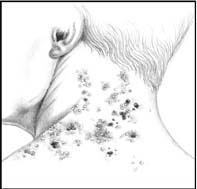Herpes zoster
Also called shingles, herpes zoster is an acute unilateral and segmental inflammation of the dorsal root ganglia caused by infection with the herpesvirus varicella-zoster, which also causes chickenpox. This infection usually occurs in adults. It produces localized vesicular skin lesions confined to a dermatome and severe neuralgic pain in peripheral areas innervated by the nerves arising in the inflamed root ganglia.
The prognosis is good unless the infection spreads to the brain. Eventually, most patients recover completely, except for possible scarring and, in corneal damage, visual impairment. Occasionally, neuralgia may persist for months or years.
Herpes zoster is found primarily in adults, especially those older than age 50. It seldom recurs.
Causes
Herpes zoster results from reactivation of varicella virus that has lain dormant in the cerebral ganglia (extramedullary ganglia of the cranial nerves) or the ganglia of posterior nerve roots since a previous episode of chickenpox.
Exactly how or why this reactivation occurs isn’t clear. Some believe that the virus multiplies as it’s reactivated and that it’s neutralized by antibodies remaining from the initial infection. However, if effective antibodies aren’t
present, the virus continues to multiply in the ganglia, destroy the host neuron, and spread down the sensory nerves to the skin.
present, the virus continues to multiply in the ganglia, destroy the host neuron, and spread down the sensory nerves to the skin.
Signs and symptoms
Herpes zoster usually runs a typical course with classic signs and symptoms. Serious complications sometimes occur.
Onset of disease
Herpes zoster begins with fever and malaise. Within 2 to 4 days, severe deep pain, pruritus, and paresthesia or hyperesthesia develop, usually on the trunk and occasionally on the arms and legs in a dermatomal distribution. Pain may be continuous or intermittent and usually lasts from 1 to 4 weeks.




